NCERT Solutions | Class 12 Chemistry Chapter 13 | Amines

CBSE Solutions | Chemistry Class 12
Check the below NCERT Solutions for Class 12 Chemistry Chapter 13 Amines Pdf free download. NCERT Solutions Class 12 Chemistry were prepared based on the latest exam pattern. We have Provided Amines Class 12 Chemistry NCERT Solutions to help students understand the concept very well.
NCERT | Class 12 Chemistry
| Book: | National Council of Educational Research and Training (NCERT) |
|---|---|
| Board: | Central Board of Secondary Education (CBSE) |
| Class: | 12th |
| Subject: | Chemistry |
| Chapter: | 13 |
| Chapters Name: | Amines |
| Medium: | English |
Amines | Class 12 Chemistry | NCERT Books Solutions
NCERT Exercises
NCERT Solutions for Class 12 Chemistry Chapter 13, Question 1.
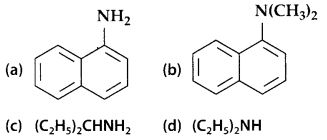
Amines class 12 NCERT Solutions:
(a) Primary
(b) Tertiary
(c) Primary
(d) Secondary
NCERT Solutions for Class 12 Chemistry Chapter 13, Question 2.
(b) Write IUPAC names of all the isomers.
(c) What type of isomerism is exhibited by different pairs of amines?
Amines class 12 NCERT Solutions:
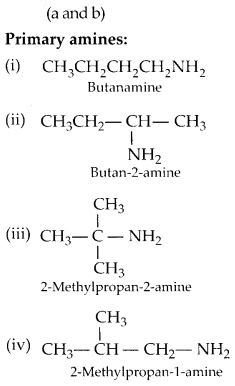

NCERT Solutions for Class 12 Chemistry Chapter 13, Question 3.
Solution.

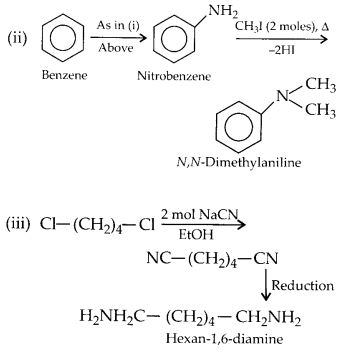
NCERT Solutions for Class 12 Chemistry Chapter 13, Question 4.
(a) C2H5NH2, C6H5NH2, NH3, C6H5CH2NH2 and (C2H5)2NH
(b) C2H5NH2, (C2H5)2NH, (C2H5)3N, C6H5NH2
(c) CH3NH2< (CH3)2NH, (CH3)3N, C6H5NH2> C6H5CH2NH2.
Amines class 12 NCERT Solutions:
(a) The order of basicity is C6H5NH2 < NH3 < C6H5CH2NH2 < C2H5NH2 < (C2H5)2NH
The basic nature of amine arises from their ability to donate the lone pair of electrons on N to electrophiles. The availability of this l.p. depends on two factors :
(i) Electron donating/withdrawing effect of the alkyl groups attached to the N atom.
(ii) Steric hindrance posed by alkyl groups around N.
The presence of alkyl groups on the N atom increases the electron density and makes the l.p. more available for electrophiles. This happens due to the +1 effect of the alkyl groups. But, if the alkyl groups are too bulky or too many in number, they tend to sterically hinder the incoming proton and the basic strength decreases. These two factors working in opposing directions, tend to balance out each other in 2° amines, making them most basic and the basic strength follows the order :
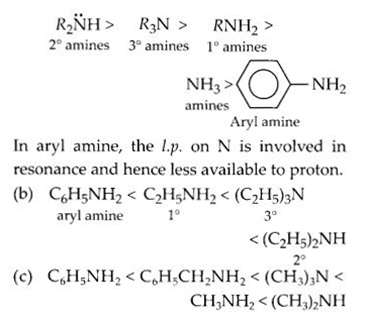
NCERT Solutions for Class 12 Chemistry Chapter 13, Question 5.
- CH3CH2CH2NH2 + HCl →
- (C2H5)3N + HCl →
Solution.

NCERT Solutions for Class 12 Chemistry Chapter 13, Question 6.
Solution.
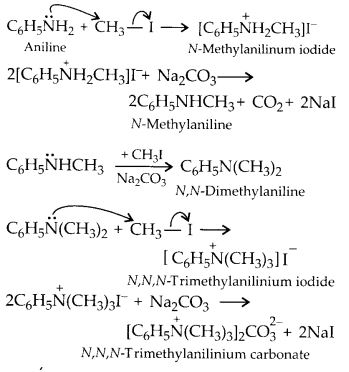
NCERT Solutions for Class 12 Chemistry Chapter 13, Question 7.
Solution.

NCERT Solutions for Class 12 Chemistry Chapter 13, Question 8.
Solution.
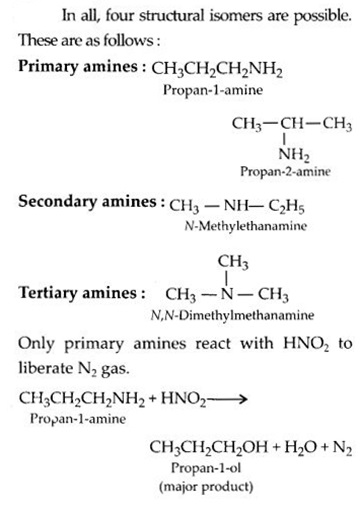

NCERT Solutions for Class 12 Chemistry Chapter 13, Question 9.
- 3-Methylaniline into 3-nitrotoluene
- Aniline into 1,3,5-tribromobenzene.
Solution.
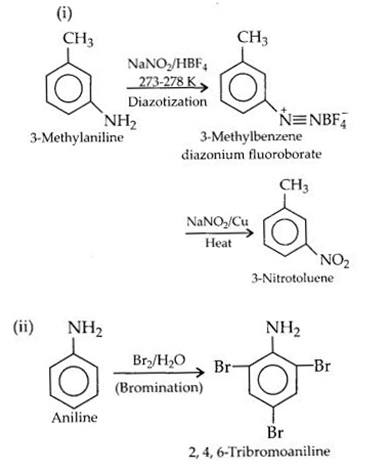
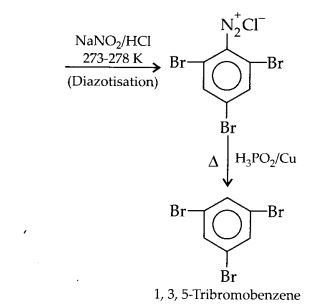
NCERT Exercises
NCERT Solutions for Class 12 Chemistry Chapter 13, Question 1.
- (CH3)2CHNH2
- CH3(CH2)2NH2
- CH3NHCH(CH3)2
- (CH3)3CNH2
- C6H5NHCH3
- (CH3CH2)2NCH3
- m-BrC6H4NH2
Solution.
- Propan-2-amine (primary),
- Propan-l-amine (primary),
- N-Methylpropan-2-amine (secondary),
- 2-Methylpropan-2-amine (primary),
- N-Methylbenzenamine or N-Methylaniline (secondary),
- N-Ethyl-N-methylethanamine (tertiary),
- 3-Bromobenzenamine or 3-Bromoaniline (primary).
NCERT Solutions for Class 12 Chemistry Chapter 13, Question 2.
- Methylamine and dimethylamine
- Secondary and tertiary amine
- Ethylamine and W-methylaniline
- Aniline and benzylamine
- Aniline and N-methylaniline
Solution.


NCERT Solutions for Class 12 Chemistry Chapter 13, Question 3.
(i) pKb of aniline is more than that of methylamine.
(ii) Ethylamine is soluble in water whereas aniline is not.
(iii) Methylamine in water reacts with ferric chloride to precipitate hydrated ferric oxide.
(iv) Although amino group is o- and p-directing in aromatic electrophilic substitution reactions, aniline on nitration gives a substantial amount of m-nitroaniline.
(v) Aniline does not undergo Friedel-Crafts reaction.
(vi) Diazonium salts of aromatic amines are more stable than those of aliphatic amines.
(vii) Gabriel phthalimide synthesis is preferred .for synthesising primary amines.
Solution.
(i) If the pKb value of any base or compound is higher than that of another, it implies that the former is a weaker base than the latter. In aniline, the N-atom is attached to the benzene ring and therefore the lone pair on N is delocalised over the entire benzene ring. As a result, it cannot accept a proton or any other electrophile.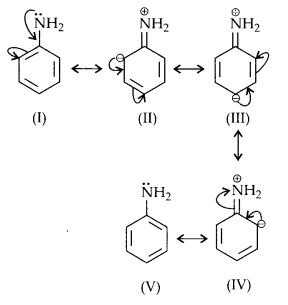
This is why it has a lower Kb value (lower basic strength) and high corresponding pKb value.
In methylamine, CH3NH2, the electron density on nitrogen is greater than that in case of aniline. This is because -CH3 group in methylamine, by virtue of its +1 effect, increases electron density on N, which is more available for protonation.
(ii) Any compound capable of forming hydrogen bonds with water, dissolves in it. Ethylamine is able to do the same and hence its solubility.

However, in aniline, the bulky hydrocarbon part – C6H5 prevents the formation of effective hydrogen bonding and therefore it is not soluble.
(iii) The formation of hydrated ferric oxide may be understood by taking into consideration the basic strength of CH3NH2. In presence of CH3NH2, water hydrolyses as
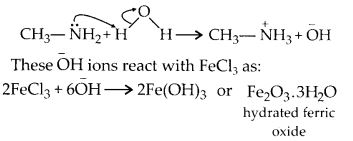
(iv) During nitration, the nitration mixture used (cone. HNO3 and cone. H2SO4) protonates the NH2 group to produce anilinium ion as
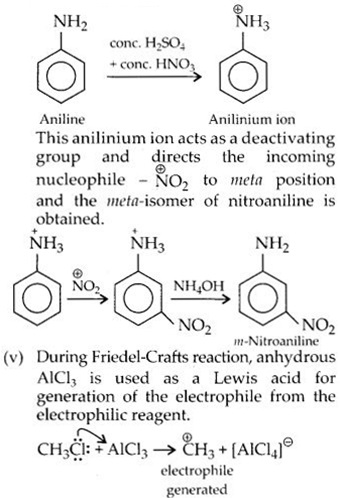
But when this reaction is carried out with aniline, no electrophile generation takes place. The reason being the presence of aniline as a base.
Aniline is a Lewis base, reacts with AlCl3 and hence deactivates it. The Lewis acid is therefore no more available for electrophile generation and hence reaction does not take place.
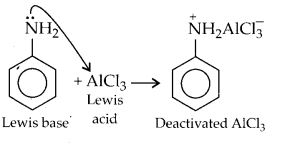
(vi) Diazonium salts carry a N atom with a positive charge. This positive charge is well dispersed in aromatic diazonium salts through resonance as shown below :
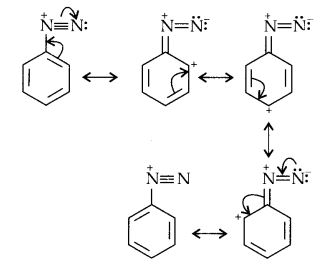
Such a charge delocalisation is not possible in aliphatic amines and hence they are less stable.
(vii) Gabriel phthalimide reaction gives pure primary amines without any contamination of secondary and tertiary amines. Therefore, it is preferred for synthesising primary amines.
NCERT Solutions for Class 12 Chemistry Chapter 13, Question 4.
(i) In decreasing order of the pKb values: C2H5NH2, C6H5NHCH3, (C2H5)2NH and C6H5NH2
(ii) In increasing order of basic strength: C6H5NH2, C6H5N(CH3)2, (C2H5)2NH and CH3NH2
(iii) In increasing order of basic strength:
(a) Aniline, p-nitroaniline and p-toluidine
(b) C6H5NH2, C6H5NHCH3, C6H5CH2NH2.
(iv) In decreasing order of basic strength in gas phase : C2H5NH2, (C2H5)2NH, (C2H5)3N and NH3
(v) In increasing order of boiling point: C2H5OH, (CH3)2NH, C2H5NH2
(vi) In increasing order of solubility in water: C6H5NH2, (C2H5)2NH, C2H5NH2.
Solution.
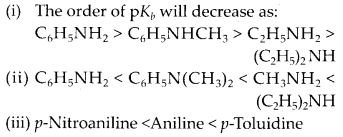

The availability of l.p. on N of p-nitroaniline is drastically reduced by presence of electron withdrawing -NO2 group on it.
In contrast, presence of electron releasing -CH3 group increases the electron density on N atom and improves basicity in p-toluidine.
(b) C6H5NH2 < C6H5NHCH3 < C6H5CH2NH2 Involvement of l.p. of N in resonance causes aniline to have low basicity. In II, the -Me group through its +I effect improves the electron density on N and therefore its basic strength increases. In III, the -NH2 is farther off from benzene ring and hence l.p. is localized on it and hence the basic strength is highest.
(iv) In gas phase, basicity follows the order : (C2H5)3N > (C2H5)2NH > C2H5NH2 > NH3 In gas phase, the stabilization by solvation is not present and hence basic strength follows the expected order based on +I effect of alkyl groups.
(v) (CH3)2NH < C2H5NH2 < C2H5OH
(vi) C6H5NH2 < (C2H5)2NH < C2H5NH2
Amines can form hydrogen bonds with water and are therefore soluble in it. However, the solubility decreases if the mass of the hydrocarbon part increases.
NCERT Solutions for Class 12 Chemistry Chapter 13, Question 5.
- Ethanoic acid into methanamine
- Hexanenitrile into 1-aminopentane
- Methanol to ethanoic acid
- Ethanamine into methanamine
- Ethanoic acid into porpanoic acid
- Methanamine into ethanamine
- Nitromethane into dimethylamine
- Propanoic acid into ethanoic acid?
Solution.

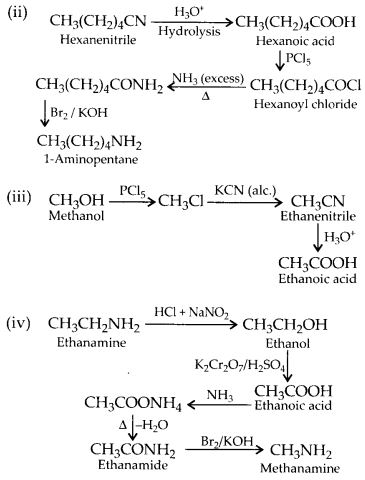
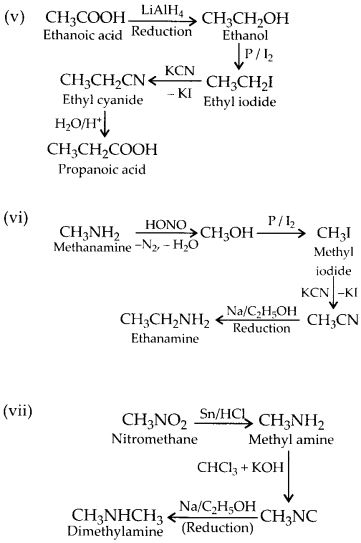

NCERT Solutions for Class 12 Chemistry Chapter 13, Question 6.
Solution.
1°,2° and 3° amines can be distinguished by Hinsberg’s reagent.
NCERT Solutions for Class 12 Chemistry Chapter 13, Question 7.
- Carbylamine reaction
- Diazotisation
- Hofmann’s bromamide reaction
- Coupling reaction
- Ammonolysis
- Gabriel phthalimide synthesis
- Acetylation
Solution.
(i) Carbylamine reaction : Aliphatic and aromatic primary amines on heating with chloroform and ethanolic potassium hydroxide form isocyanides or carbylamines which are foul smelling substances. Secondary and tertiary amines do not show this reaction. This reaction is known as carbylamine reaction or isocyanide test and is used as a test for primary amines.
(ii) Diazotisation : The conversion of primary aromatic amines into diazonium salts is known as diazotisation.
The conversion is brought about by reacting the amine with HNO2 which is prepared in situ.

(iii) Hofmann’s bromamide reaction : Primary amides when heated with Br2 and (aqueous or ethanoic solution of) NaOH lose a carbon atom and are converted to the corresponding amines. It is an example of step-down reaction.

(iv) Coupling reaction : The reaction of diazonium salts with phenols and aromatic amines to form azo compounds having an extended conjugate system with both aromatic rings joined through the — N = N — bond, is called coupling reaction. In this reaction, the nitrogen atoms of the diazo group are retained in the product. The coupling with phenols takes place in mildly alkaline medium while that with amines occurs under faintly acidic conditions. For example,
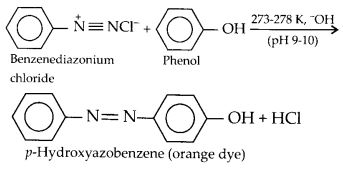
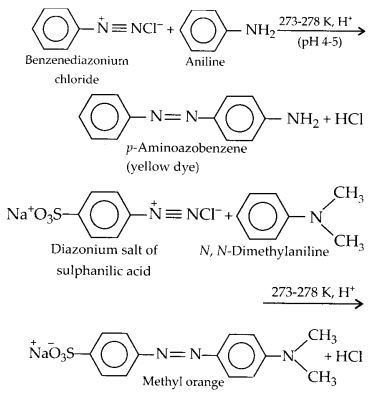
Coupling generally occurs at the p-position with respect to the hydroxyl or the amino group, if free, otherwise it takes place at the o-position.
(v) Ammonolysis : The process of cleavage of the C — X bond in alkyl halides by ammonia molecule is called ammonolysis. 1° amine thus obtained behaves as a nucleophile and further reacts with alkyl halide to form 2°, 3° and finally quaternary ammonium salt.

(vi) Gabriel phthalimide synthesis : In this reaction phthalimide is converted into its potassium salt by treating it with alcoholic potassium hydroxide. Then potassium phthalimide is heated with an alkyl halide to yield an N-alkylpthalimide which is hydrolysed to phthalic acid and primary amine by alkaline hydrolysis.
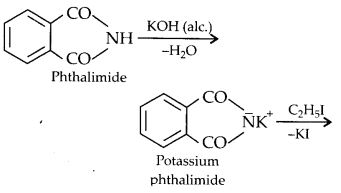
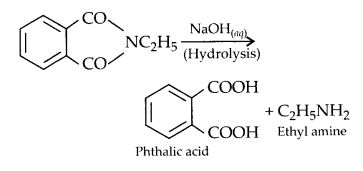
This synthesis is very useful for the preparation of pure aralkyl and aliphatic primary amines. However, aromatic primary amines cannot be prepared by this method.

NCERT Solutions for Class 12 Chemistry Chapter 13, Question 8.
- Nitrobenzene to benzoic acid
- Benzene to m-bromophenol
- Benzoic acid to aniline
- Aniline to 2,4,6-tribromofluorobenzene
- Benzyl chloride to 2-phenylethanamine
- Chlorobenzene to p-chloroaniline
- Aniline to p-bromoaniline
- Benzamide to toluene
- Aniline to benzyl alcohol.
Solution.



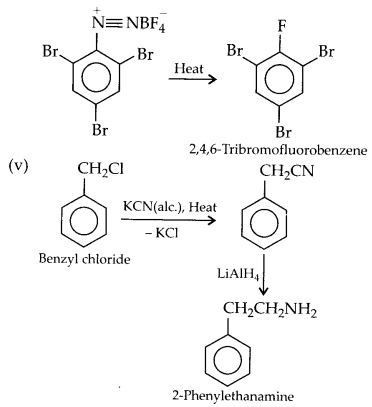
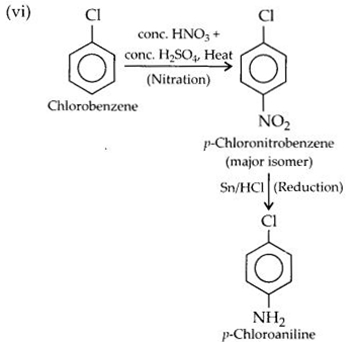
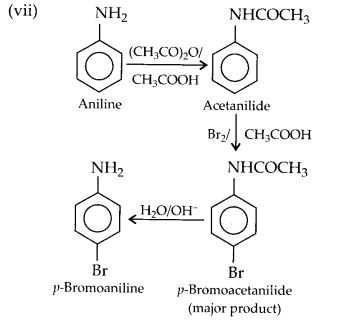
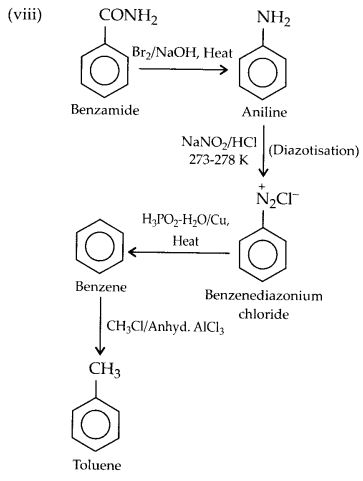
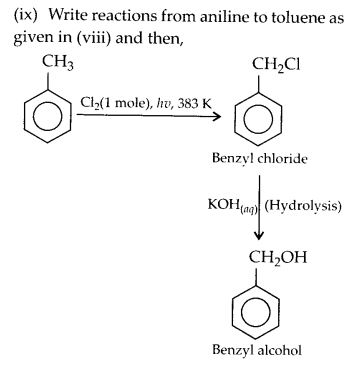
NCERT Solutions for Class 12 Chemistry Chapter 13, Question 9.
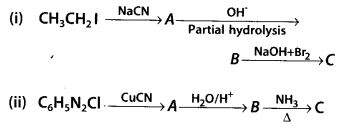

Solution.

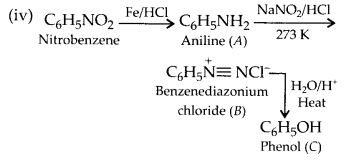
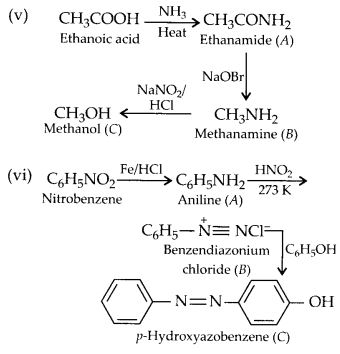
NCERT Solutions for Class 12 Chemistry Chapter 13, Question 10.
Solution.
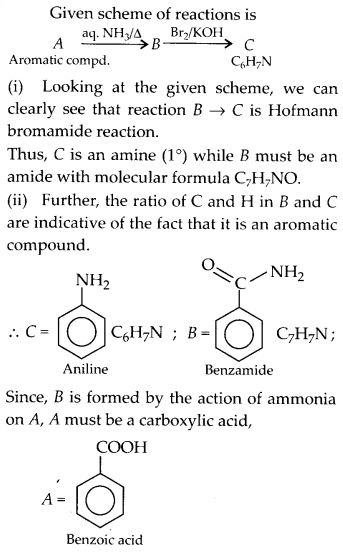

NCERT Solutions for Class 12 Chemistry Chapter 13, Question 11.

Solution.


NCERT Solutions for Class 12 Chemistry Chapter 13, Question 12.
Solution.
(i) Gabriel phthalimide reaction involves the nucleophilic attack of the phthalimide on the alkyl halide.
(ii) Such a nucleophilic substitution reaction is not possible if the substrate is an aryl halide.
(iii) The reason for it can be explained on the basis of
(a) Partial double bond character of C — X bond in aryl halide. Consider the following structures :
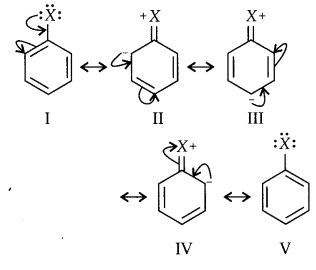
From the resonance structures we see that the C — X bond has a double bond character in structures II, III and IV and this makes cleavage of C — X bond difficult.
(b) Also the steric hindrance by the bulky aryl group prevents the incoming nucleophile.
NCERT Solutions for Class 12 Chemistry Chapter 13, Question 13.
Solution.
Amines do not directly react with nitrous acid, rather they react with a mixture of dil. HCl and NaNO2 and HNO2 is produced in situ.The reactions are :

NCERT Solutions for Class 12 Chemistry Chapter 13, Question 14.
(i) Why are amines less acidic than alcohols of comparable molecular masses?
(ii) Why do primary amines have higher boiling point than tertiary amines?
(iii) Why are aliphatic amines stronger bases than aromatic amines?
Solution.
(i) Loss of a proton from an amine gives RNH– ion while loss of a proton from alcohol gives RO- ion as shown below :
As O is more electronegative than N,RO– can accommodate the negative charge more easily than the RNH– can.
As, RO– is more stable than RNH– the former is formed more. As a result, amines are less acidic than alcohols.
(ii) (a) At boiling point, the molecules in a compound break free from their inter molecular forces and escape into the vapour phase.
Weaker the inter-molecular forces, lower will be the boiling point.
(b) In 1 ° amines, there is strong H-bonding that binds the amine molecules together. Whereas in 3° amine absence of H on N atom prevents hydrogen bonding completely.
This is why 1° amines have higher boiling point.

(iii) (a) The basic nature of amines is a result of the presence of l.p. of electron on the N atom. Also the electron density is increased on N due to the +I effect of alkyl group.
(b) In aryl amines the l.p. on N is involved in resonance with the benzene ring and hence less available for protonation.
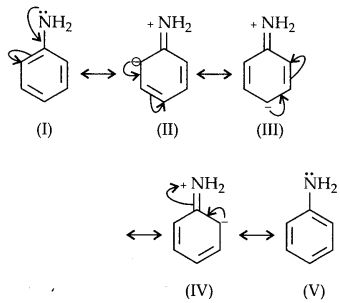
(c) In aliphatic amines there is no such delocalisation and hence it is more basic.
NCERT Class 12 Chemistry
Class 12 Chemistry Chapters | Chemistry Class 12 Chapter 13
Chapterwise NCERT Solutions for Class 12 Chemistry
-
NCERT Solutions For Class 12 Chemistry Chapter 1 The Solid State
NCERT Solutions For Class 12 Chemistry Chapter 2 Solutions
NCERT Solutions For Class 12 Chemistry Chapter 3 Electro chemistry
NCERT Solutions For Class 12 Chemistry Chapter 4 Chemical Kinetics
NCERT Solutions For Class 12 Chemistry Chapter 5 Surface Chemistry
NCERT Solutions For Class 12 Chemistry Chapter 6 General Principles and Processes of Isolation of Elements
NCERT Solutions For Class 12 Chemistry Chapter 7 The p Block Elements
NCERT Solutions For Class 12 Chemistry Chapter 8 The d and f Block Elements
NCERT Solutions For Class 12 Chemistry Chapter 9 Coordination Compounds
NCERT Solutions For Class 12 Chemistry Chapter 10 Haloalkanes and Haloarenes
NCERT Solutions For Class 12 Chemistry Chapter 11 Alcohols Phenols and Ethers
NCERT Solutions For Class 12 Chemistry Chapter 12 Aldehydes Ketones and Carboxylic Acids
NCERT Solutions For Class 12 Chemistry Chapter 13 Amines
NCERT Solutions For Class 12 Chemistry Chapter 14 Biomolecules
NCERT Solutions For Class 12 Chemistry Chapter 15 Polymers
NCERT Solutions For Class 12 Chemistry Chapter 16 Chemistry in Everyday Life
| NCERT Solutions for Class 12 All Subjects | NCERT Solutions for Class 10 All Subjects |
| NCERT Solutions for Class 11 All Subjects | NCERT Solutions for Class 9 All Subjects |

Post a Comment
इस पेज / वेबसाइट की त्रुटियों / गलतियों को यहाँ दर्ज कीजिये
(Errors/mistakes on this page/website enter here)